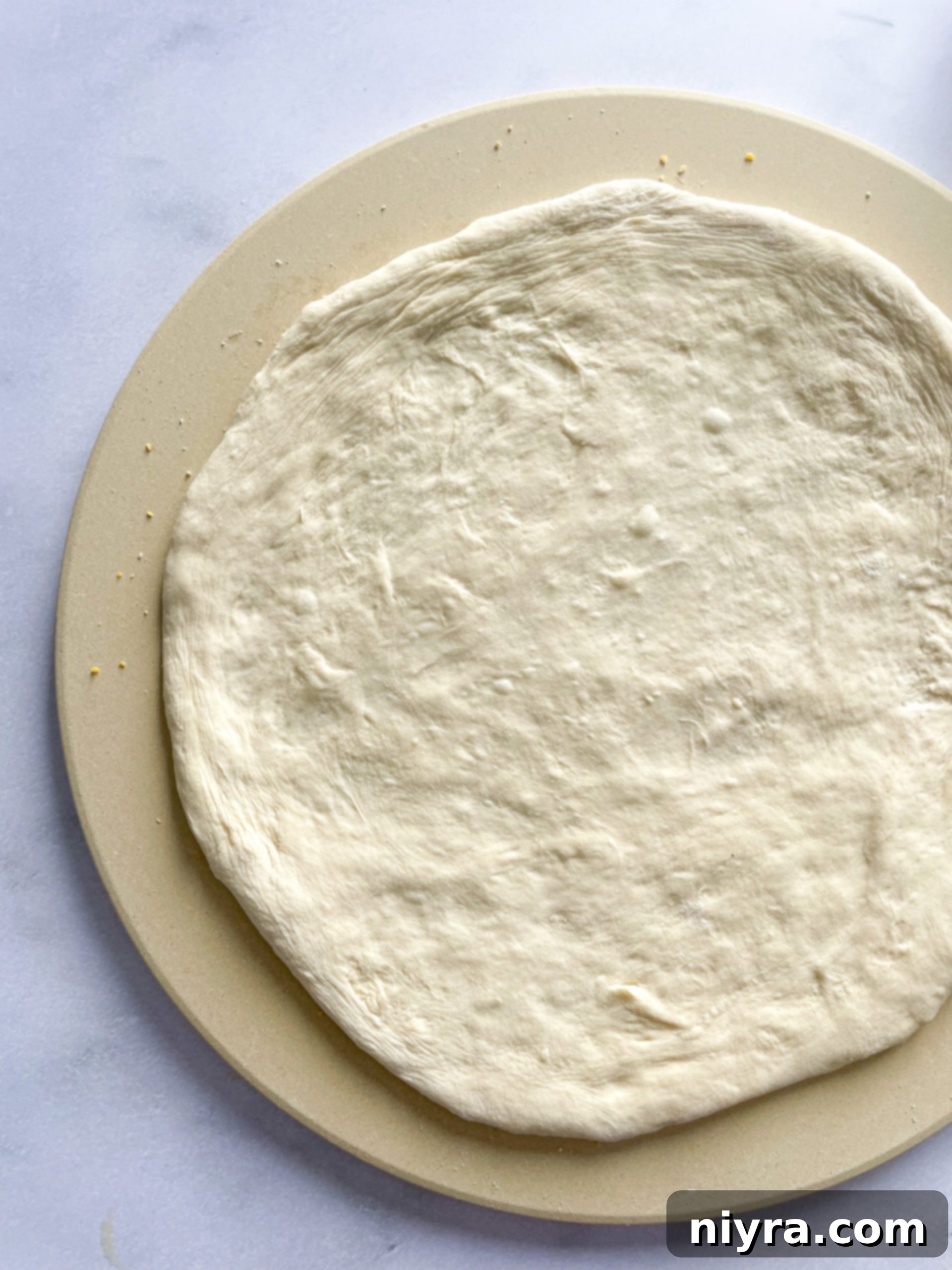Do you yearn for the authentic taste and satisfying texture of homemade pizza, crafted right in your own kitchen? If so, the foundation of that perfect pie lies in an exceptional pizza dough. This comprehensive guide is dedicated to providing you with an incredibly easy-to-follow recipe that consistently yields superb results. Whether you prefer a light, crisp thin crust or a robust, chewy thick crust, this **homemade pizza dough** recipe is guaranteed to make your favorite pizza toppings shine even brighter!
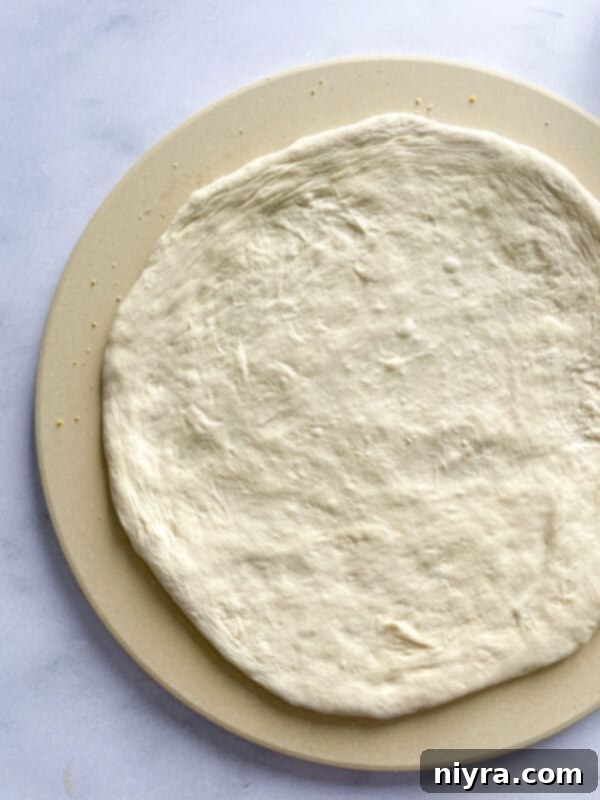
For many years, our family would enjoy what we called “homemade pizza,” a label primarily earned because it wasn’t a takeout order from our local pizzeria. However, the truth was often a reliance on pre-made refrigerated crusts or convenient box mixes. While these options offered a quick fix, they never quite delivered the true depth of flavor or the satisfying chew of an authentic, scratch-made crust. That culinary journey took a delightful turn the moment I discovered this particular recipe and method for crafting homemade pizza dough. The transformation in taste and texture was immediate and profound, opening up a world of possibilities for truly personalized and unforgettable pizza nights.
Why This Easy Homemade Pizza Dough Will Become Your Favorite
The notion of making pizza dough from scratch might seem like a task best left to professional chefs, but I assure you, with this recipe, you have all the tools to succeed! This isn’t just a good pizza dough recipe; it’s arguably the **best easy pizza dough recipe** you’ll encounter. By following these clear, step-by-step instructions, you’re on your way to creating delicious homemade pizza with confidence. While it requires patience due to several hours of crucial proofing time, the hands-on effort is surprisingly minimal. The beauty of this recipe lies in its simplicity, utilizing only four core ingredients that are readily available.
The versatility of this dough extends far beyond classic pizzas. Imagine transforming it into savory calzones bursting with fillings, rustic breadsticks perfect for dipping, elegant baguettes, or even sweet, comforting cinnamon rolls. The potential for culinary creativity is immense. For an immediate and delightful savory application, I highly recommend trying our Pepperoni Pizza Bread, which pairs perfectly with this dough.
Pizza is universally loved and always a good idea, whether you’re planning a casual dinner, preparing a crowd-pleasing appetizer, or hosting a game day gathering. And once you experience the superior flavor and unparalleled satisfaction of a crust made with your own hands, you’ll likely never want to go back to store-bought alternatives. The depth of flavor developed through proper proofing is simply unmatched.
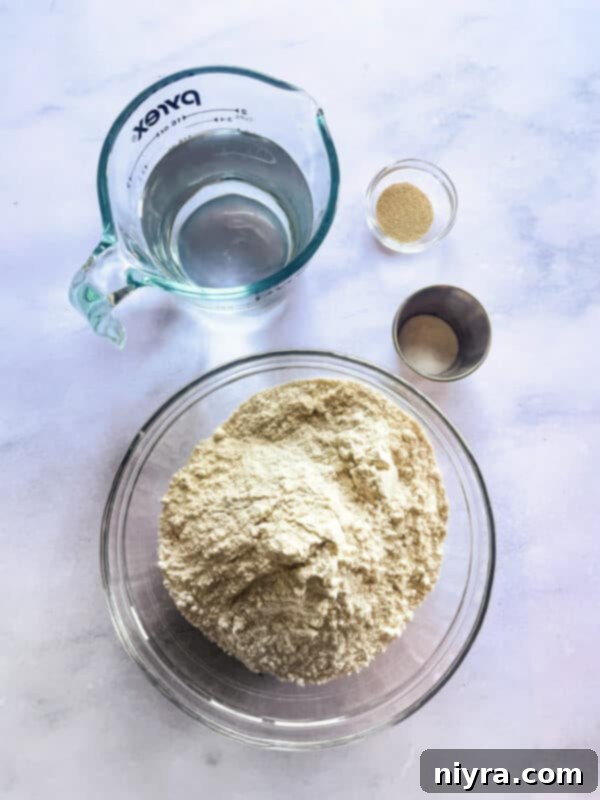
Key Ingredients for the Ultimate Pizza Dough Recipe
You will find the complete, detailed measurements and comprehensive instructions within the printable recipe card located at the very end of this post.
- Bread Flour: For crafting the absolute best pizza dough with a satisfying chew and robust structure, bread flour is the top choice. Its higher protein content facilitates greater gluten development, which is essential for trapping gas during fermentation, resulting in a lighter, airier, and more elastic crust. This superior gluten network also makes the dough easier to stretch and handle. While all-purpose flour can work in a pinch, it will yield a crispier, less chewy crust due lacking the same protein levels.
- Water: The temperature of your water is a critical factor for successful yeast activation. Always use room temperature water, ideally between 78-81 degrees Fahrenheit (25-27 degrees Celsius). This specific temperature range is optimal for active dry yeast to thrive and multiply, producing the essential gases that give your pizza dough its rise and texture. Allowing your water to sit out for at least 15-30 minutes before use will help it reach this ideal temperature.
- Active Dry Yeast: This recipe is optimized for active dry yeast, renowned for its consistent and reliable performance. If you only have instant yeast (often labeled as rapid rise), it can be substituted, but you will need to adjust the quantity. Use approximately 25 percent less instant yeast than active dry yeast – meaning for this recipe, about 0.75 grams of instant yeast. Unlike active dry yeast, instant yeast does not require prior proofing and can be added directly to your dry ingredients.
- Salt: More than just a flavor enhancer, salt plays a crucial role in controlling the rate of yeast fermentation and strengthening the gluten structure in the dough. Sea salt is recommended for its clean flavor, but fine Himalayan pink salt or standard table salt are perfectly acceptable substitutes. Ensure it’s evenly distributed for balanced flavor and texture.
- Oil: A very small amount of a neutral oil, such as olive oil, is used solely to lightly grease the bowl where the dough will rise. This prevents the dough from sticking and ensures easy removal without deflating its delicate structure.
The Precision of Measurement: Grams vs. Cups for Dough
It’s important to note that for superior results in baking, especially when making dough, ingredients are best measured by weight (grams) rather than by volume (cups). While both measurements are provided in this recipe, measuring in grams will yield a significantly more consistent and improved outcome. The fundamental difference between grams and cups is the distinction between weight and volume. A cup of flour, for instance, can vary dramatically in actual weight depending on how densely it’s packed, scooped, or even the humidity in your kitchen. This inherent variability in volumetric measurements can lead to inconsistent dough hydration, directly impacting the final texture of your pizza crust.
By using a food scale to weigh your ingredients in grams, you ensure absolute precision and consistency every single time. This method eliminates the guesswork and variations associated with scooping, guaranteeing that your dough will have the exact hydration level intended by the recipe. This precision is why professional bakers and pizzaiolos globally rely exclusively on scales. It allows for perfect replication of recipes and ensures predictable, high-quality results. While this is particularly critical for flour and water, applying it to all ingredients elevates your baking. If you don’t yet own a food scale, the volumetric measurements are provided for convenience, but consider investing in one for truly professional-level baking.
Mastering the Craft: How to Make This Easy Pizza Dough Recipe
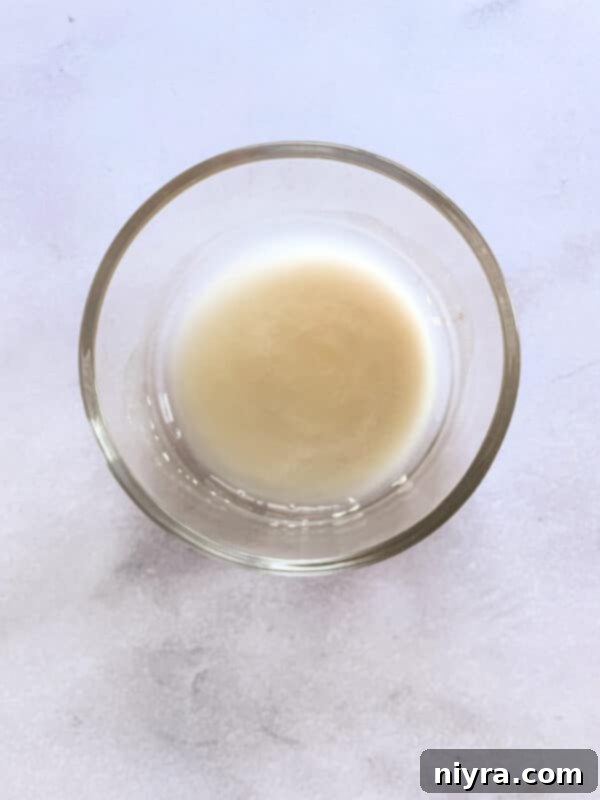
Step 1: Hydrate the Dough. Begin by adding 350 grams (1 ½ cups) of room temperature water to a large mixing bowl. It’s crucial that the water registers between 78-81 degrees Fahrenheit (25-27 degrees Celsius). This specific warmth is vital for the active dry yeast to become fully active and begin its crucial work. To achieve this, simply let your tap water sit out for at least 15 minutes before measuring its temperature with a food thermometer.
Step 2: Activate the Yeast. In a separate, smaller bowl, combine the 1 gram (¼ teaspoon) of active dry yeast with 2 tablespoons of the room temperature water from your large bowl. Stir gently and set it aside. Over the next 5-10 minutes, you should observe the yeast mixture becoming foamy or bubbly, indicating that the yeast is alive and active – a positive sign for your dough’s rise.

Step 3: Initial Flour & Water Mix (Autolyse). Return to the large bowl containing the remaining water. Add the 500 grams (about 4 ⅓ cups) of bread flour to the water. Mix these two ingredients together until they are just incorporated and no dry pockets of flour remain. The mixture will appear shaggy and sticky. Cover the bowl loosely with plastic wrap or a damp kitchen towel and let it rest for 30 minutes. This resting period, known as the autolyse, allows the flour to fully hydrate and gluten development to begin naturally, making the dough easier to work with later.
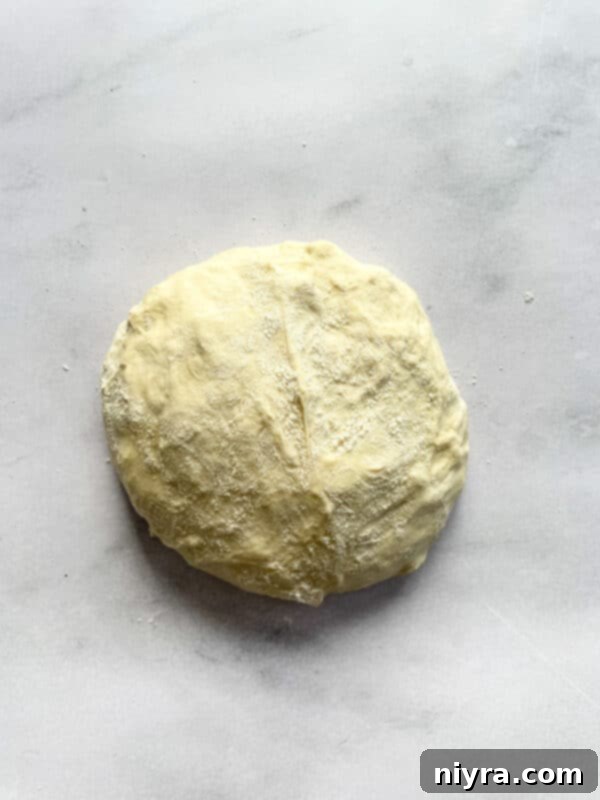
Step 4: Incorporate Salt and Activated Yeast. After the 30-minute autolyse, sprinkle the 10 grams (½ Tablespoon + ⅓ teaspoon) of sea salt evenly over the top of the dough. Next, pour the entire activated yeast mixture from Step 2 into the bowl. With your hands, gently mix and fold the dough repeatedly until the salt and yeast are fully incorporated. This process distributes these essential ingredients throughout the dough mass.
Now, it’s time for kneading. You can either knead the dough by hand on a lightly floured surface or utilize a stand mixer fitted with a dough hook attachment. If using a stand mixer, mix on a low speed for approximately 4-5 minutes. The dough should transform into a soft, smooth, and elastic ball that pulls away from the sides of the bowl. If kneading by hand, this process will take a bit longer, roughly 8-10 minutes, until it achieves the same supple consistency.
Step 5: First Rise with a Fold. Lightly oil a clean, large bowl with olive oil. Transfer the kneaded dough into this oiled bowl, ensuring it’s coated on all sides. Cover the bowl tightly with plastic wrap or a damp cloth to prevent the surface from drying out. Allow the dough to begin its primary fermentation (first rise). After 30 minutes, perform a “stretch and fold” technique: gently pull a section of the dough from underneath, stretch it upwards, and fold it over onto the center. Rotate the bowl and repeat this process 3-4 times around the entire dough ball. This action helps build strength and structure. Re-cover the bowl and let the dough continue to rise at room temperature for a full 6 hours. This long, slow proofing is critical for developing deep flavor and a beautiful texture.
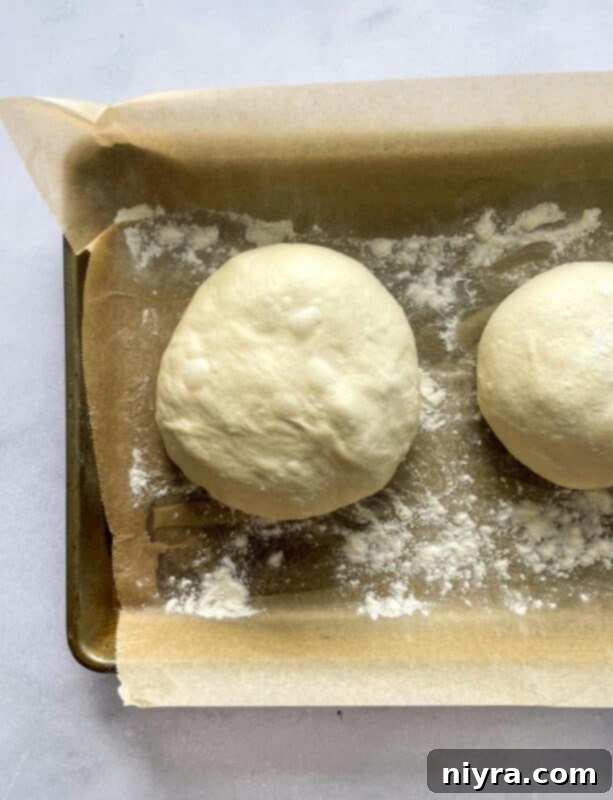
Step 6: Divide and Second Proof. Once the dough has completed its impressive 6-hour rise, gently turn it out onto a lightly floured work surface. Carefully divide the dough into two equal portions. Gently shape each portion into a smooth, round ball. Place these dough balls onto a lightly floured baking sheet, ensuring they have sufficient space between them. Lightly flour the tops of the dough balls, then cover them once again with plastic wrap or a clean towel. Allow them to undergo a second proofing (final rise) for another 30-60 minutes at room temperature. This prepares them perfectly for shaping and baking.
Step 7: Prepare Your Oven and Pizza Stone. While your dough is undergoing its final proof, it’s imperative to prepare your baking environment. Preheat your oven to its highest possible setting, typically ranging from 475-550 degrees Fahrenheit (245-290 degrees Celsius). Place your pizza stone or a heavy baking steel inside the oven as it preheats. Allowing the stone to get intensely hot for at least 30-60 minutes is crucial for achieving that coveted crispy crust characteristic of pizzeria-style pizza.
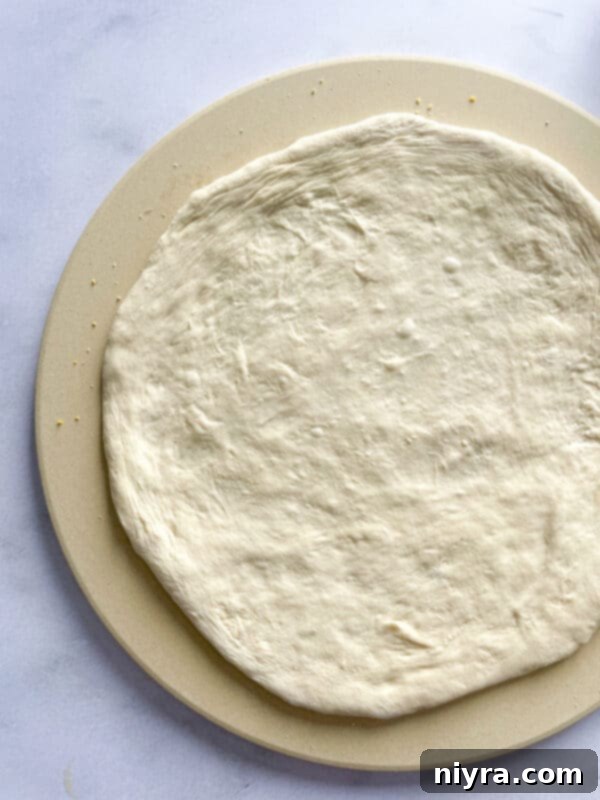
Step 8: Shape the Dough for Baking. Before shaping, perform the “finger dent test” to confirm your dough is perfectly proofed. Gently press the dough with your knuckle or a finger. If it springs back slowly but still leaves a small indent, it’s ready for baking. If it springs back immediately, it needs more proofing time. When ready, lightly flour your work surface once more. Take one dough ball and, using a rolling pin or your hands, gently stretch and roll it out to your desired thickness and diameter. This recipe yields two pizza crusts: you can opt for two 12-inch thick-crust pizzas or two 14-inch thin-crust pizzas, depending on your preference.
Loving this recipe? Pin It for Future Pizza Nights!
Don’t let this fantastic homemade pizza dough recipe disappear into the internet ether! Be sure to pin it to your favorite Pinterest board before you go. That way, you’ll always have this reliable recipe at your fingertips whenever a pizza craving strikes!
From Dough to Delight: Baking Your Homemade Pizza
With your expertly prepared pizza dough ready, the next exciting step is to assemble and bake your culinary creation. Carefully transfer your shaped pizza dough onto a lightly floured pizza peel. Spread your desired pizza sauce evenly over the crust, leaving a small border around the edges for the perfect handle. Then, add your favorite toppings, being mindful not to overload the pizza, as too many toppings can prevent even cooking and lead to a soggy crust. I’ve included a selection of my favorite pizza recipes below to give you some inspiration!
After your pizza stone has had ample time to preheat in the oven (at least 30 minutes *after* the oven reached its highest temperature), carefully slide your assembled pizza onto the scorching hot stone using the pizza peel. Close the oven door quickly to retain heat. Bake for approximately 8-12 minutes, or until the crust is beautifully golden brown and crispy, and the cheese is melted, bubbly, and slightly caramelized at the edges. Keep in mind that baking times can vary slightly based on your specific oven and the thickness of your pizza crust.
Once baked to perfection, use your pizza peel to carefully remove the hot pizza from the oven. Transfer it to a cutting board and allow it to cool for a few minutes before slicing. This brief resting period helps the cheese set and prevents the toppings from sliding off when you cut into it. Slice, serve, and bask in the glory of your truly exceptional homemade pizza!

Delicious Pizza Recipes to Enjoy with Your Homemade Dough
Now that you have confidently mastered the art of making flawless homemade pizza crust, it’s time to unleash your culinary creativity! Feel free to experiment with a variety of sauces, cheeses, and fresh toppings to invent your own signature pizza. Alternatively, if you’re seeking some delicious inspiration, consider trying one of these fantastic pizza recipes, each perfectly complemented by your versatile, scratch-made dough:
- Spinach Artichoke Alfredo Pizza (as pictured above – a creamy, rich, and utterly delicious option!)
- Buffalo Chicken Pizza (perfect for those who crave a spicy and tangy kick!)
- Chicken Pesto Pizza (a fresh, aromatic, and vibrant choice)
- Reuben Pizza (an unexpected yet incredibly flavorful fusion)
Explore Pizza-Inspired Recipes Beyond the Pie:
The love for pizza doesn’t have to be confined to a traditional round pie! This dough and its flavors can inspire a myriad of other delightful dishes:
- Pizza Pasta
- Pepperoni Pizza Grilled Cheese
- Pizza Dip
- Open Faced Pizza Burgers
- Browse All My Pizza Recipes Here!
Frequently Asked Questions About Homemade Pizza Dough
- What are the core ingredients of basic pizza dough? Fundamentally, basic pizza dough is comprised of flour, water, active dry yeast, and salt. Sometimes, a small amount of olive oil is also included for added flavor and to improve the dough’s texture and elasticity.
- Which flour type is best for homemade pizza dough? For a truly thick, chewy, and airy crust, bread flour is the superior choice. Its higher protein content facilitates greater gluten development, leading to a dough that’s more elastic, easier to stretch, and capable of producing a more open, bubbly crumb structure. If you prefer a crispier, thinner crust, all-purpose flour is a better option, as its lower protein content will result in a less chewy, more brittle final product.
- What is a pizza peel, and why do I need one? A pizza peel is an essential tool for any home pizzaiolo, essentially functioning as a large, flat spatula. Its primary purpose is to effortlessly transfer your assembled pizza into a blazing hot oven (especially onto a pizza stone or steel) and then safely retrieve it once baked. This prevents burns, spills, and helps maintain the pizza’s perfect round shape. You’ll observe this tool being used in every professional pizzeria.
- What are bakers’ percentages? Bakers’ percentages, also known as baker’s math, is a standardized method for writing and scaling recipes in professional baking. It expresses the weight of each ingredient as a percentage of the total flour weight, which is always set at 100%. For example, if a recipe uses 500 grams of flour and 350 grams of water, the hydration is 70% (350/500 * 100). This system ensures incredible precision, consistency, and easy scalability of recipes, making it indispensable for professional bakers. For an excellent detailed explanation, you can visit King Arthur Baking’s resource on Bakers’ Percentage.
- Can I freeze homemade pizza dough? Absolutely! Freezing pizza dough is a convenient way to prepare ahead and have fresh dough on demand. Once your pizza dough has completed its full rise and is ready to be baked, simply portion it into individual balls. Lightly oil each ball, then place it into a freezer-safe bag, pressing out as much air as possible. You can safely freeze your dough for up to three months. When you’re ready to use it, thaw the frozen dough in the refrigerator overnight, then allow it to come to room temperature for 1-2 hours before shaping and baking.
- How long can pizza dough be stored in the refrigerator? After the first rise, pizza dough can be kept in an airtight container or a tightly sealed plastic bag in the refrigerator for up to three days. The cold temperature significantly slows down yeast activity, allowing for a longer, slower fermentation which can actually enhance the dough’s flavor complexity. Always remember to bring the refrigerated dough to room temperature for approximately 1-2 hours before shaping and baking.
Expert Tips and Tricks for Achieving the Perfect Pizza Crust
- The Right Water Temperature is Paramount: Always use water that is comfortably at room temperature, ideally between 78-81 degrees Fahrenheit (25-27 degrees Celsius), when activating your active dry yeast. This narrow temperature range is optimal for yeast to become fully active and multiply, which is absolutely vital for a well-risen, airy, and flavorful pizza dough. To achieve this, let your water sit out for at least 15-30 minutes before incorporating it.
- Create an Ideal Proofing Environment: When proofing your dough, after lightly oiling the bowl with olive oil to prevent sticking, ensure it’s covered tightly with plastic wrap or a damp cloth. Place the covered bowl in a warm, draft-free location. A slightly warm (but turned off) oven or a cozy spot in your kitchen can provide the consistent temperature needed for an even and effective rise.
- Don’t Rush the Proofing Process: Patience is a key ingredient in great pizza making. If your dough doesn’t pass the “finger dent test” – where a gentle press with your finger leaves a small indent that slowly springs back – it needs more time to proof. If it springs back immediately, it’s under-proofed. If it collapses completely, it might be over-proofed, but still generally usable with careful handling. Adequate proofing is essential for a light, digestible, and airy crust.
- Smart Storage for Leftover Dough: If your recipe yields more dough than you need for one sitting, don’t let it go to waste! Place the unused dough ball in an airtight, resealable bag or container. It can be stored safely in the refrigerator for up to 3 days, or in the freezer for up to 3 months. When ready to use, thaw refrigerated dough at room temperature for an hour, or frozen dough overnight in the fridge, then bring to room temp before shaping.
- Thoroughly Preheat Your Pizza Stone: For a crust with incredible crispness that rivals a professional brick oven, dedicate ample time to preheating your pizza stone or baking steel. Place it in the oven as you preheat to its highest temperature, and then allow it to continue heating for at least 30-60 minutes *after* the oven has reached temperature. This intense residual heat transfer to the dough’s base is what creates that desirable crispy texture.
- Avoid Over-Topping Your Pizza: While it’s tempting to load up your pizza with all your favorite ingredients, remember that excessive toppings can lead to a soggy crust and uneven cooking. A balanced distribution allows the heat to circulate effectively, ensuring everything cooks through and the crust remains crisp and delicious.
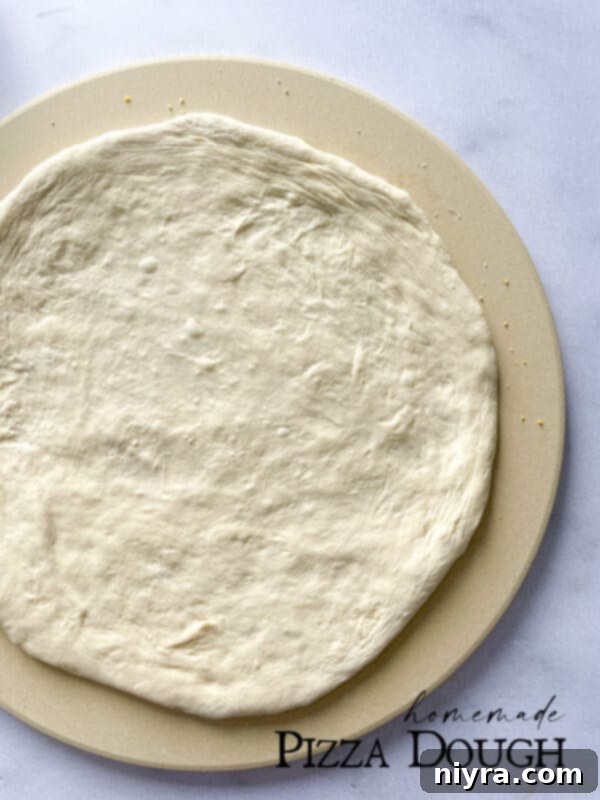
Make tonight a memorable PIZZA NIGHT with this fantastic homemade pizza dough! With a little advanced planning for the dough, you can effortlessly bring the joy of custom pizza to your family. They will undoubtedly love the experience of creating their own unique pizza masterpieces, and you will relish the satisfaction of serving restaurant-quality pizza made from scratch. Truly, pizza is always a good time for everyone!

Homemade Pizza Dough Recipe
LIKE THIS RECIPE?
Don’t forget to give it a ⭐️⭐️⭐️⭐️⭐️ star rating and
leave a comment below the recipe!
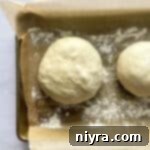
This simple recipe guarantees a delicious homemade pizza every time. Homemade from start to finish, whether rolled into a light, crisp thin crust or an epic thick crust, this homemade pizza dough recipe is sure to make your favorite pizza pie toppings even better!
Recipe At a Glance
- Prep Time: 15 minutes
- Cook Time: 10 minutes
- Additional Time (Proofing): 8 hours
- Total Time: 8 hours 25 minutes
- Course: Breads
- Cuisine: American/Italian
- Keywords: active dry yeast, bread flour, homemade pizza dough, pizza crust, pizza dough
- Servings: 2 pizza crusts
- Author: Michaela Kenkel
Equipment Needed
- KitchenAid Gourmet Rolling Pin, One Size, Red
- Kitchenaid Stand Mixer (optional, for kneading efficiency)
- OUII Aluminum Pizza Peel Metal – 12 x 14 Inch
- KitchenAid Classic Pizza Wheel (optional, for easy slicing)
- 14” Pizza Cutter by KitchenStar | Rocker Style (optional, for large pizzas)
- Large mixing bowls
- Small bowl
- Measuring cups and spoons (or a kitchen scale for precision)
- Food thermometer (recommended for water temperature)
- Plastic wrap or a damp kitchen towel
- Baking sheet
- Pizza stone or heavy baking steel
Ingredients
- 500 grams (about 4 ⅓ cups) Bread Flour
- 350 grams (1 ½ cups) room temperature Water, divided
- 1 gram (¼ teaspoon) Active Dry Yeast
- 10 grams (½ Tablespoon + ⅓ teaspoon) Sea Salt
- A small amount of Olive Oil (for greasing the bowl)
Instructions
- Prepare Water: Add 350 grams (1 ½ cups) of room temperature water (ideally 78-81°F / 25-27°C) into a large mixing bowl. Set it aside.
- Activate Yeast: In a separate, smaller bowl, place 1 gram (¼ teaspoon) of active dry yeast. Add 2 tablespoons of water from the large bowl to the yeast. Stir gently and set aside for 5-10 minutes until it becomes foamy, indicating activation.
- Combine Flour & Water (Autolyse): Add 500 grams (4 ⅓ cups) of bread flour to the remaining water in the large bowl. Mix until just incorporated and no dry flour remains. The mixture will be shaggy. Cover the bowl and let it rest for 30 minutes.
- Incorporate Salt & Yeast: After 30 minutes, sprinkle 10 grams (½ Tablespoon + ⅓ teaspoon) of sea salt over the dough. Add the activated yeast mixture. Mix by hand, folding the dough until both salt and yeast are fully incorporated.
- Knead the Dough: Knead the dough by hand on a lightly floured surface for 8-10 minutes, or use a stand mixer with a dough hook on low speed for about 4-5 minutes, until the dough is soft, smooth, and elastic.
- First Rise & Fold: Lightly oil a clean large bowl. Place the kneaded dough ball inside and cover tightly with plastic wrap. After 30 minutes, perform a “stretch and fold” (pull dough up, fold over, rotate, repeat). Re-cover and let rise at room temperature for 6 hours.
- Divide & Second Proof: Gently remove the risen dough onto a lightly floured surface. Divide it into two equal balls. Shape each into a smooth ball and place on a lightly floured baking sheet. Lightly flour the tops, cover, and let proof for another 30-60 minutes.
- Preheat Oven & Stone: While the dough proofs, preheat your oven to its highest possible setting (475-550°F / 245-290°C) with your pizza stone or baking steel inside for at least 30-60 minutes.
- Shape the Pizza Crust: Perform the finger dent test: if an indent slowly springs back, the dough is ready. On a floured surface, roll or stretch the dough to your desired thickness. This recipe makes two 12-inch thick crusts or two 14-inch thin crusts.
- Assemble Pizza: Transfer the shaped dough to a floured pizza peel. Add your favorite sauce and toppings.
- Bake Pizza: Carefully slide the assembled pizza onto the preheated pizza stone in the oven. Bake for 8-12 minutes, or until the crust is golden brown and bubbly.
- Cool & Serve: Remove the pizza from the oven using the peel. Transfer to a cutting board and let cool for a few minutes before slicing and enjoying your incredible homemade pizza!
Recipe Notes
- Precision in Measurement: For the most consistent and superior results, we strongly recommend measuring all ingredients, especially flour and water, by weight (grams) using a kitchen scale. Volumetric measurements (cups) can vary significantly, impacting dough hydration and final texture. Professional bakers rely on scales for this precision.
- Recipe Yield: This recipe is designed to yield two individual pizza crusts. You have the flexibility to create two 12-inch pizzas with a delightfully thicker crust, or two 14-inch pizzas for a crispier, thinner experience, according to your preference.
- Adapted Recipe: This outstanding recipe has been thoughtfully adapted from Ken Forkish’s highly regarded Same Day Straight Pizza Dough recipe, known for its consistent excellence.
Nutrition Information (Approximate, Per Serving – 1 pizza crust)
- Calories: 134 kcal
- Carbohydrates: 27g
- Protein: 4g
- Fat: 1g
- Sodium: 200mg
- Fiber: 1g
